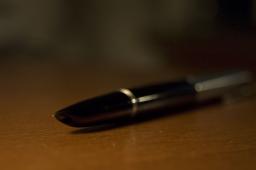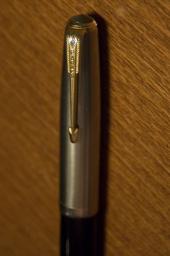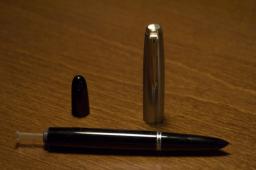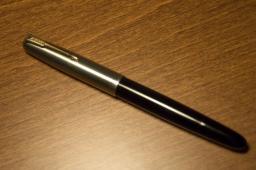
Meet The Parkers, Part ‘51’
 I’ve long been a fan of Parker fountain pens, but have always had modern Parkers. Come to think of it, until recently I don’t think I’ve ever owned a pen manufactured before I graduated from high school, never mind before I was born. Thanks to a chance encounter at Stylo Pens a few weeks ago, that’s changed.
I’ve long been a fan of Parker fountain pens, but have always had modern Parkers. Come to think of it, until recently I don’t think I’ve ever owned a pen manufactured before I graduated from high school, never mind before I was born. Thanks to a chance encounter at Stylo Pens a few weeks ago, that’s changed.
It came up in conversation with another patron that I’d hoped to get a Parker ‘61’ (essentially a ‘51’ but with a capillary filler) but had lost the eBay auction to get the one I’d found. Turns out the chap I was speaking with was the one who beat me to the ‘61’. As a consolation, he invited me to try out the ‘51’ he had just finished restoring.
 The Parker ‘51’ is arguably the eternal flagship of the Parker Pen Company. Sold from 1941 to 1972, plus a converter-based homage to the original in 2002 called the «’51′ Special Edition», The ‘511 is far from Parker’s oldest model as it is far from its newest but, probably the model with which Parker added the most innovative features at one time, making it widely popular and with the possible exception of the Duofold, the most recognizable as a Parker. In advertisements, Parker boasted that the ‘51’ was «the world’s most wanted pen» and despite the decidedly self-serving and unscientific manner in which the information they claimed was collected, it was likely true.
The Parker ‘51’ is arguably the eternal flagship of the Parker Pen Company. Sold from 1941 to 1972, plus a converter-based homage to the original in 2002 called the «’51′ Special Edition», The ‘511 is far from Parker’s oldest model as it is far from its newest but, probably the model with which Parker added the most innovative features at one time, making it widely popular and with the possible exception of the Duofold, the most recognizable as a Parker. In advertisements, Parker boasted that the ‘51’ was «the world’s most wanted pen» and despite the decidedly self-serving and unscientific manner in which the information they claimed was collected, it was likely true.  This particular Parker is a vacumatic filler, storing the ink directly in the barrel without a sac or other container in the barrel. The ink is pulled up into the pen from the vacuum created when the plunger is pulled back. That’s basically how modern twist converters work, and come to think of it, except for eyedropper-fill pens and pens that use cartridges, almost all fountain pens pull the ink in with the vacuum created from the expansion of the internal chamber. Vacumatics were made until 1948 when they were replaced with the aerometric system, which used an internal sac to hold ink. The most immediately distinctive feature of the ‘51’ is its hooded nib, designed to expose as little of the nib and feed to the air until it hit the paper, allowing the use of fast-drying ink without clogging.
This particular Parker is a vacumatic filler, storing the ink directly in the barrel without a sac or other container in the barrel. The ink is pulled up into the pen from the vacuum created when the plunger is pulled back. That’s basically how modern twist converters work, and come to think of it, except for eyedropper-fill pens and pens that use cartridges, almost all fountain pens pull the ink in with the vacuum created from the expansion of the internal chamber. Vacumatics were made until 1948 when they were replaced with the aerometric system, which used an internal sac to hold ink. The most immediately distinctive feature of the ‘51’ is its hooded nib, designed to expose as little of the nib and feed to the air until it hit the paper, allowing the use of fast-drying ink without clogging.
The design gives the ‘51’ a modern look, at least in comparison to most fountain pens, which don’t vary much from the nib design used in dip pens since the steel pen was invented. Come to think of it, the hood and nib of the ’51′ sort of resembles the tip of a quill pen. Perhaps everything old really does become new again. I wouldn’t have taken this home if writing with it weren’t a delicious treat. The 14kt gold nib is pretty darn stiff, typical for pens made at that point in history. There are pros and cons and tradeoffs to a fine, stiff nib like this, but the final result is a smooth, reliable line with very little variation. The ‘51’ glides across paper and lends itself to speedy writing without quirks or problems. It’s much lighter than I generally prefer my pens to be, but its other characteristics more than make up for that.
Owning a pen like this is a reminder of how things ought to be. Rarely in today’s advancements in technology does anything work right the first time and keep going for more than a few months, never mind a few years. This pen was made 62 years ago and while it may have had some parts replaced along the way, it’s a better writer than the majority of pens made in the last 62 months. 1945 Parker ‘51’: filled weight 18 grams 
Nice piece, Steve!
I’ve
Nice piece, Steve!
I’ve noted a few of your posts on FPN, and I was excited to see that you have a blog.
The Parker 51 is one of my favorite writing instruments, too. And, like you, I started my vintage collection with one — in fact, a 1945 as well. I’ve often made the comment that the 51 is probably the most reliable pen in the world, and I know I’ll always have a handful in my collection. Terrific writers, well built and comfortable to write with, and while some don’t “get” the styling, they’re still going to be one of my “go-to” pens.
BTW…what quarter was your 1945 made in?